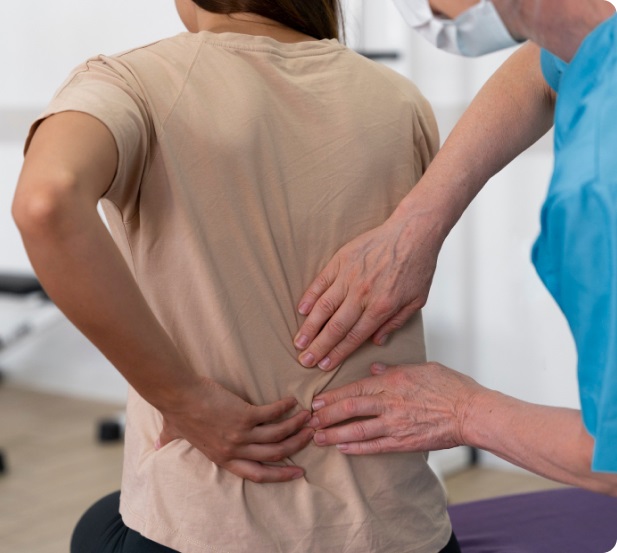Sports Medicine
Sports medicine is a medical field focused on preventing, diagnosing, and treating sports-related injuries and conditions, as well as enhancing athletic performance and overall physical fitness.

Sports medicine is a medical field focused on preventing, diagnosing, and treating sports-related injuries and conditions, as well as enhancing athletic performance and overall physical fitness.


Ligament injuries involve damage to the tough, fibrous tissues that connect bones and stabilize joints. These injuries often result from excessive force, such as twisting, overstretching, or direct impact, and are commonly seen in sports or accidents. Symptoms include pain, swelling, bruising, and joint instability. Depending on the severity, ligament injuries are classified as sprains: Grade 1 involves stretching with minor damage, Grade 2 is a partial tear, and Grade 3 is a complete tear or rupture.
Read More
Meniscal tears are injuries to the menisci, which are two crescent-shaped pieces of cartilage located in the knee joint between the femur and tibia. These structures act as shock absorbers, providing cushioning and stability during movement. Meniscal tears often occur due to sudden twisting, pivoting, or impact, making them common in sports-related activities. Symptoms typically include knee pain, swelling, stiffness, and a reduced range of motion.
Read More
Shoulder injuries encompass various types of damage to the structures within or surrounding the shoulder joint, including muscles, tendons, ligaments, and cartilage. Common shoulder injuries often result from trauma, repetitive motion, or degenerative conditions. Two significant types of shoulder injuries are Bankart lesions and rotator cuff tears.Bankart lesions involve damage to the labrum, a ring of cartilage that stabilizes the shoulder joint, often occurring due to shoulder dislocations.
Read More
The Anterior Cruciate Ligament (ACL) is a crucial ligament located in the knee joint. Comprising tough fibrous tissue, it connects the femur (thigh bone) to the tibia (shin bone) and plays a vital role in stabilizing the knee during various movements
Read More
Preparing for PCL (Posterior Cruciate Ligament) surgery involves several key steps. Consultation with the surgeon is essential for understanding the procedure, potential risks, and expected outcomes. Preoperative assessments, including imaging, help in planning the surgery.
Read More
Meniscus repair is a surgical procedure aimed at treating tears in the meniscus, the C-shaped cartilage in the knee that cushions and stabilizes the joint. When a meniscus tear occurs, especially in the vascularized outer region, repair becomes a preferred option.
Read More
The MPFL, or Medial Patellofemoral Ligament, is a crucial stabilizing structure in the knee. It runs along the inner side of the knee, connecting the patella (kneecap) to the femur (thigh bone). The primary function of the MPFL is to prevent excessive lateral movement or dislocation of the patella during knee flexion and extension. Patellar dislocation can occur when there's an injury or traumatic event that disrupts the MPFL.
Read MoreWe will help choose the best Treatment/Procedure for your condition.
Sports medicine is a specialized field focused on the prevention, diagnosis, treatment, and rehabilitation of injuries related to sports and exercise. It involves a multidisciplinary approach, combining expertise from physicians, physical therapists, athletic trainers, and nutritionists to optimize athletic performance and recovery. Common issues addressed in sports medicine include muscle strains, ligament sprains, fractures, and overuse injuries. The field also emphasizes enhancing physical fitness and advising on safe training practices. Sports medicine professionals work with athletes of all levels, from amateur enthusiasts to elite professionals, ensuring they remain healthy and perform at their bes
You should see an orthopedic surgeon for sports medicine problems if you experience severe pain, swelling, instability, or inability to bear weight on the affected limb. Persistent symptoms that do not improve with rest, ice, compression, and elevation (RICE) or physical therapy also warrant a visit. Additionally, if you suspect a fracture, dislocation, or a major ligament or tendon injury, an orthopedic evaluation is necessary. Orthopedic surgeons can provide advanced diagnostic tools like MRI and offer treatments ranging from non-surgical interventions to surgical procedures to repair or reconstruct damaged structures.
Not all ligament injuries require surgical management. Treatment depends on the severity, location, and functional demands of the injured ligament. Minor sprains or partial tears often respond well to conservative measures such as rest, ice, compression, elevation (RICE), and physical therapy to restore strength and stability. However, complete tears, especially in weight-bearing joints like the knee (e.g., ACL tears), may necessitate surgical intervention to restore full function and prevent further joint damage. The decision for surgery is individualized, considering the patient's activity level, age, and overall health.
The timeline for resuming work after arthroscopic surgery depends on the specific procedure performed, the joint involved, and the nature of your job. Generally, patients can return to sedentary or desk jobs within one to two weeks, while those with physically demanding jobs may need to wait six to eight weeks or longer. Your surgeon will provide personalized recommendations based on your recovery progress, pain levels, and range of motion. Adherence to post-operative rehabilitation exercises and follow-up appointments is crucial to ensure a safe and effective return to work.
Multi-ligament correction involves the surgical repair or reconstruction of multiple damaged ligaments in a single joint, commonly seen in complex knee injuries. Such injuries often occur due to high-energy trauma, such as sports injuries or accidents, resulting in significant instability and functional impairment. The surgical procedure typically includes the use of grafts to replace torn ligaments and may involve other techniques to address associated injuries like meniscal tears or cartilage damage. Rehabilitation after multi-ligament correction is intensive and prolonged, focusing on restoring joint stability, strength, and range of motion to achieve optimal recovery.